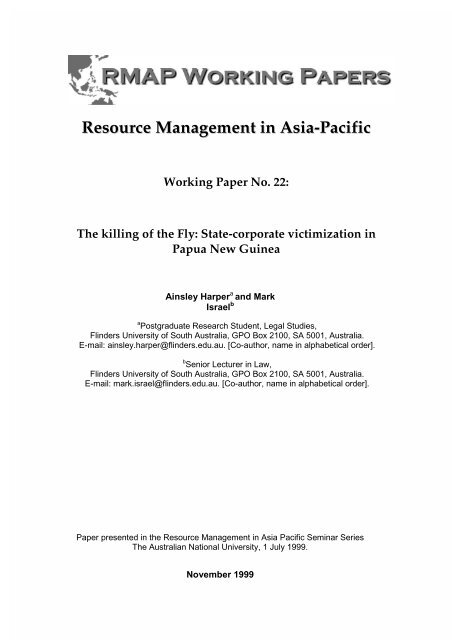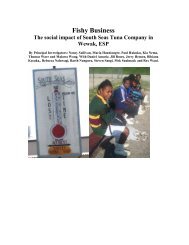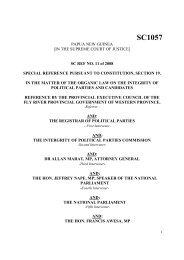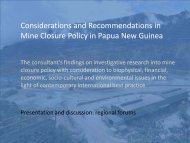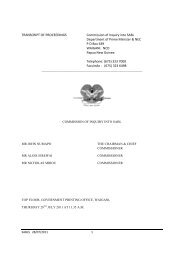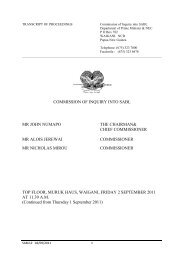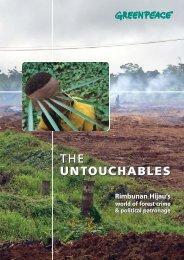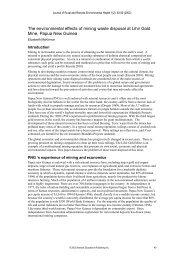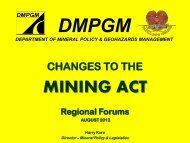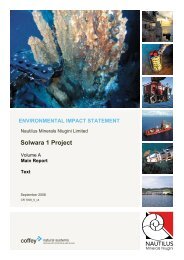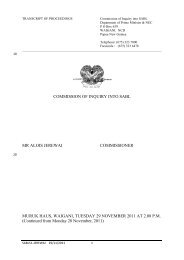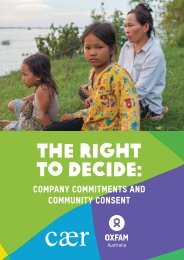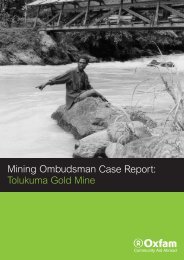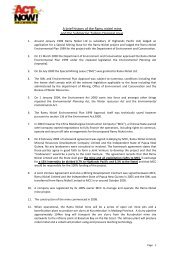Working Paper 1999/22 - ANU - Digital Collections - Australian ...
Working Paper 1999/22 - ANU - Digital Collections - Australian ...
Working Paper 1999/22 - ANU - Digital Collections - Australian ...
Create successful ePaper yourself
Turn your PDF publications into a flip-book with our unique Google optimized e-Paper software.
Resource Management in Asia-Pacific<strong>Working</strong> <strong>Paper</strong> No. <strong>22</strong>:The killing of the Fly: State-corporate victimization inPapua New GuineaAinsley Harper a and MarkIsrael ba Postgraduate Research Student, Legal Studies,Flinders University of South Australia, GPO Box 2100, SA 5001, Australia.E-mail: ainsley.harper@flinders.edu.au. [Co-author, name in alphabetical order].b Senior Lecturer in Law,Flinders University of South Australia, GPO Box 2100, SA 5001, Australia.E-mail: mark.israel@flinders.edu.au. [Co-author, name in alphabetical order].<strong>Paper</strong> presented in the Resource Management in Asia Pacific Seminar SeriesThe <strong>Australian</strong> National University, 1 July <strong>1999</strong>.November <strong>1999</strong>
The correct citation for this publication is:Authors: Ainsley Harper and Mark IsraelYear of Publication: <strong>1999</strong>Title: The killing of the Fly: State-corporate victimization in Papua New GuineaSeries: Resource Management in Asia Pacific <strong>Working</strong> <strong>Paper</strong> No. <strong>22</strong>Publisher: Resource Management in Asia Pacific Project, Research School of Pacific and AsianStudies, The <strong>Australian</strong> National UniversityEditor: Michael PretesPlace of Publication: CanberraISSN-1444-187X
Resource Management in Asia Pacific<strong>Working</strong> <strong>Paper</strong>sThe Resource Management in Asia Pacific <strong>Working</strong> <strong>Paper</strong> series seeks to provide readers with accessto current research on environmental and resource issues in the Asia Pacific region. <strong>Working</strong> <strong>Paper</strong>sproduced by the Project aim to facilitate discussion and debate on critical resource management issuesin the area, and to link scholars working in different disciplines and regions.Publication as a ‘<strong>Working</strong> <strong>Paper</strong>’ does not preclude subsequent publication in scholarly journals orbooks; indeed, it may facilitate publication by providing feedback from readers to authors.Unless otherwise stated, publications of the Resource Management in Asia Pacific Project arepresented without endorsement as contributions to the public record and debate. Authors areresponsible for their own analysis and conclusions.Resource Management in Asia Pacific ProjectResearch School of Pacific and Asian StudiesThe <strong>Australian</strong> National UniversityCanberra ACT 0200 AustraliaTel: +61 2 6125 9978Fax: +61 2 6125 4896Email: rmap@coombs.anu.edu.au
AbstractOver the past fourteen years, the Ok Tedi mining project run by BHP in Papua New Guinea has causedextensive damage to the environment by discharging untreated cyanide, copper, cadmium and substantialquantities of sediment into surrounding river systems. In this paper, we consider whether the concept ofstate-corporate crime might aid analysis of the way the relationship between BHP and the nationalgovernment resulted in damage to the Fly; second, we examine how this case study might contribute toour understanding of state-corporate crime.
The killing of the Fly:State-corporate victimization in Papua New Guinea...if there is blame to be apportioned (or credit) then the State and OTML share it. (Jackson1993:160)IntroductionOver the past fourteen years, the Ok Tedi mining project in the Western Province of Papua New Guinea(PNG) has caused extensive damage to the environment by discharging untreated cyanide, copper,cadmium and substantial quantities of sediment into the surrounding river systems. As a result of thispollution the lives of thousands of villagers – people who rely on the river and adjacent lands for theirsubsistence – have been severely affected. A writ lodged in 1994 in the Supreme Court of Victoria by agroup of these villagers alleged that Australia’s largest mining company, Broken Hill Pty Co Ltd (BHP)was responsible for this pollution as the largest partner in and sole manager of the mine. 1 The case wassettled out of court in 1996, with BHP paying compensation and legal costs. Nevertheless, the events thatled to the case suggest that any credible analysis of the causes of the damage must extend well beyond theactions of BHP and consider the complex nexus that existed between ‘The Big <strong>Australian</strong>’ corporationand the PNG government. As part of this relationship, the PNG government contributed to the damage tothe Fly River system by deliberately allowing the BHP-led consortium to evade the State’s environmentallaws.We have two objectives in writing this paper: first, we consider whether reference to the conceptof state-corporate crime might be helpful to an analysis of the way the relationship between the miningcompany and the Port Moresby government resulted in the damage to the Fly; second, we examine howthis case study might contribute to the development of criminology’s understanding of state-corporatecrime.The study of state-corporate crimeCriminology has largely failed to look at state crimes in any disciplined analytical manner. There are atleast four major reasons for this failure: first, state crime is particularly complex; second, it is furtive(Barak 1990); third, there has been a tendency for criminologists to be co-opted by the state astechnocratic agents of social control (Cohen 1988); and finally, the existence of state crime has beenideologically masked (Mathiesen 1974; Barak 1991; Tunnell 1995). Part of the explanation for thismasking lies in the role the state itself plays in defining crime (Kauzlarich et al. 1992; Cohen 1993).Consequently, a criminology that seeks to bring the state into its domain of study has to develop anunderstanding of the range of ways that the state, its various institutions and agents become entangledwith crime as victims and offenders, primary and secondary definers, distributors of punishment andcompensation. In each case, criminologists should document the crimes, delineate categories, establishcausation and suggest forms of crime control (Israel 1998).Increasing concern with the state played an important part in the new, critical, radical andMarxist criminologies that emerged in the 1960s. Since then, work by criminologists on state crime hasproceeded in several different ways. Crimes have been listed (Chambliss 1989; Barak 1991; Kramer1992), causes reviewed (Fattah 1989; Harff and Gurr 1989) and techniques of abolishing, combating,controlling, decreasing, minimising, preventing and resisting state crime have been identified (Ross1995). Various typologies have also been developed. For example, David Friedrichs (1995) consideredthe range of illegal activities that occur within the context of government. He distinguished betweenpolitical crime (which was directed against the state from outside the apparatus of the state), politicalwhite collar crime (which was directed against the state from within the apparatus of the state), stateorganisedcrime (crimes undertaken by agents of the state in the interest of the state) and state-corporatecrime. This last category, state-corporate crime, offers a new focus for criminologists.The term seems to have been devised by Ronald Kramer and Raymond Michalowski as late as1990 and was redefined by Aulette and Michalowski to mean:1 BHP v Dagi [1996] 2 VR 117, 15 December 1995, Supreme Court of Victoria.
illegal or socially injurious actions that result from a mutually reinforcing interaction between1. policies and/or practices in pursuit of the goals of one or more institutions of politicalgovernance and2. policies and/or practices in pursuit of the goals of one or more institutions of economicproduction and distribution (1993:169)Investigation of state-corporate crime rests on the premise that on the one hand, in order to operate, themodern corporation requires a particular legal, economic and political infrastructure which is provided bygovernments; on the other hand, governments in capitalist states depend on corporations to supply goodsand services, provide an economic base and support government policies. In some cases, this relationshipmay facilitate criminal activities. As a result, the study of state-corporate crime links and fills a gapbetween the studies of corporate crime (with their investigation of organizational deviance within acorporation) and studies of ‘state-organised crime’, the examination of crimes resulting from the actionsof government organizations (Chambliss 1989).The concept of state-corporate crime has been explored by American criminologists through theChallenger space shuttle explosion (Kramer 1992), a fire in the Imperial Food Products chickenprocessing plant in Hamlet, North Carolina (Aulette and Michalowski 1993), the production of nuclearweapons (Kauzlarich and Kramer 1993) and in the more general area of ‘crimes of the capitalist stateagainst organised labor’ (Tunnell 1995). This small body of research on state-corporate crime delves intoareas where, for various reasons, oversight of corporate and/or state institutions by independent bodies hasbeen curtailed. For example, in the Challenger case study, Kramer noted that the American Federalgovernment body involved, the National Aeronautics and Space Administration, had only ever beensubject to self-regulation. This self-regulation had been entirely inadequate – indeed at two key sitessafety personnel had been placed under the supervision of the very offices and activities whose work theywere to monitor (President’s Commission 1986). Kauzlarich and Kramer’s work on the nuclear weaponsproduction complex in the United States also found that the Department of Energy and the privatecorporations that contracted with the Department had been allowed to work in extreme secrecy, unfetteredby the regulations that had governed the civilian nuclear industry. Again, Aulette and Michalowski’sresearch on the death of 25 workers at a chicken processing plant in North Carolina uncovered ‘aninterwoven pattern of regulatory failure on the part of several state and federal agencies’ (1993:166) thatallowed the company’s management to continue violating basic safety regulations in search of corporateprofit.We would like to make two observations about the state-corporate crime literature. First, thedefinition of state-corporate crime adopted by Aulette and Michalowski covers all socially injurious actsincluding those that are not defined by the local jurisdiction as crime. We do not subscribe to the view thatcrimes should be defined as actions that breach local (Tappan 1947; Sutherland 1949; Bohm 1993) orinternational (Schwendinger and Schwendinger 1970, 1975; Kauzlarich, Kramer and Smith 1992)criminal laws. Instead, we view definitions of crime as dynamic rather than static, reflecting not onlychanges in the law but changes in attitudes towards various forms of acts and omissions. In this sense,societies create crime because they construct the rules whose transgression constitutes crime. The state isa major player in this process and this has left any strand of criminology that is reluctant to challenge statedefinitions of crime vulnerable to charges of co-option. As Stan Cohen argued 25 years ago, we believethat criminologists should recognise the political nature of their subject matter and start to work withtopics that have been ignored by most researchers:Damage, victimization, exploitation, theft and destruction carried out by the powerful are notonly not punished but are not called ‘crime’. These are matters intimately concerned with questions ofvalues, political conflict and power. (Cohen 1973:624)However, we need to be careful. We may not like what various governments get up to, but thisdoes not always make what they do criminal (Sharkansky 1995).Although we can see the value of using the term ‘state-corporate crime’, we note that adoptingsuch a term in several of the contexts that have been investigated so far requires criminologists to defendthe use of the term ‘crime’ in a manner that has not yet been properly developed in the state-corporatecrime literature. This work has been attempted in other areas (Kramer 1985; Michalowski and Kramer1987; Muncie 1996), however for the purposes of this paper we are willing to propose what might be aslightly less tendentious concept, that of state-corporate victimization. We have done this for an importantmethodological reason: we have not visited Ok Tedi nor have we been to the rest of PNG. We have alsonot interviewed key players in the decision-making processes that we analyse. Our argument is thereforeentirely dependent on an analysis of a wide range of conflicting secondary sources.
Second, use of the concept of state-corporate crime seems to have been limited to the UnitedStates. There seems little reason to believe that the concept might not be of value in other countries. Forexample, <strong>Australian</strong> criminologists might care to apply it to the effect of Agent Orange on, among others,<strong>Australian</strong> troops in Vietnam (McCulloch 1984; Wilson 1994), and the mining of blue asbestos atWittenoom in Western Australia (Hills 1989). However, in the second part of this paper we want to usethe concept to examine the very particular kinds of relationships that have been created betweenmultinational corporations and the governments of developing countries (Ott 1985; Gladwin 1987;Pearson 1987; LeVine 1989; Dunning 1993; Muchlinski 1995). We argue that the circumstances thatresulted in environmental damage to the Ok Tedi, its environs and subsequently to the people of the FlyRiver region of Papua New Guinea also provide an example of state-corporate victimization. 2State-corporate victimization and the killing of the FlyBHP and Ok TediWestern mining companies first discovered major ore deposits in the Star Mountains of PNG in 1968.Negotiations between the PNG government and one mining corporation, Kennecott, broke down in 1975over tax and arbitration provisions (Jackson 1982; Pintz 1984) and the government approached severalother mining corporations in an attempt to find new investors. One of these companies was the <strong>Australian</strong>mining giant, BHP. BHP was already the second largest company in PNG after Bougainville Copper,operating a range of manufacturing and distributing subsidiaries (Mountjoy 1984; Pintz 1984) andmaintaining close links with leading PNG politicians (Jackson 1982). In 1976, an agreement was signedbetween the government and a subsidiary of BHP allowing the company to develop a proposal to exploitthe ore body at Ok Tedi. 3In 1980, the government allowed a BHP-led consortium to develop the mine. 4 The localindigenous people, the Wopkaimin, agreed to lease communally owned land to the consortium inexchange for compensation, a share of royalties, offers of employment, and the establishment ofeducational, social and medical facilities (Hyndman 1994). This land represented 20 per cent of the localhunting grounds (Maunsell and Partners 1982). Hopes were high for Ok Tedi. The price of gold boomedand prospects for copper seemed favourable. The project was described by the Prime Minister of PNG, SirJulius Chan, as a ‘pot of gold at the end of the rainbow’. 5 By 1984, the Ok Tedi mine had startedproducing gold. Copper production began in 1987. The copper concentrate was transported in slurry formvia a 160 kilometre pipeline to a filtering facility sited at Kiunga on the bank of the Fly River. From there,barges transported the concentrate 850 kilometres to a bulk handling silo vessel in the Gulf of Papua.Concentrates were sold on medium and long term contracts to smelters in Japan, Finland, Germany, SouthKorea and the Philippines. By the mid 1990s, after Amoco Mineral Corporation had sold its shares, BHPhad been able to consolidate its position in Ok Tedi Mining Limited (OTML) by taking 52.6 per centequity, leaving the Canadian company Inmet Mining Corporation (a subsidiary of the German company,Metallgesellschaft) with 17.4 per cent and the PNG government with 30 per cent. Ok Tedi was producing350,000 ounces of gold and 200,000 tonnes of copper annually, 6 with export sales in 1994/1995 of A$980million, 7 and annual profits of about $250 million.However, it had been a long hard struggle for BHP. Richard Jackson, an <strong>Australian</strong> geographer,was a member of several PNG government committees that planned the development of Ok Tedi. Heconcluded that, until 1988, the project had proved to be an ‘unmitigated disaster’ for the consortium(Jackson 1993:168). Indeed,2 PNG has not attracted much attention from criminologists. Australia has however sent out ‘visiting experts’ tocomment on local conditions (Boehringer and Giles 1977). Two early collections were complied by Biles (1976)and Clifford et al. (1984). More recent research has been conducted on rascals (Harris 1988), violence againstwomen (Strathern 1985) and law and order problems (Morauta 1986; Dinnen 1986, 1993).3 Mining (Ok Tedi Agreement) Act, <strong>22</strong>/3/76. At the beginning, the consortium comprised BHP’s subsidiary DampierMining Company, Amoco Corporation, and Metallgesellschaft AG, DeGussa and DEG of West Germany.Subsequently, the PNG State took up a 20 per cent shareholding in the project. The other shareholders were BHP(30 per cent), Amoco (30 per cent), Metallgesellschaft (7.5 per cent) and DEG (five per cent).4 Mining (Ok Tedi Supplemental Agreement) Act, 26/6/80.5 Quoted in Jackson (1982:148).6 “Aurient Resources Announcement” Reuters Financial Service, 4/2/97.7 “Focus – Australia’s BNP Settles Mine Dispute with Villagers”. Reuters Financial Service, 11/6/96.
...the project’s performance provided overwhelming evidence that multinational companies areby no means as omniscient or as fiendishly clever as they are usually depicted but are capable ofthe same lack of foresight and blessed with the same proclivity to create monumental stuff ups aseveryone else. (1993:169)The costs of construction had been badly underestimated by the consortium. The ore deposit was situatedin a seismically active part of Western Province at an elevation of 2,440 metres above sea-level on Mt.Fubilan, a steeply sloping, jungle-clad mountain 850 kilometres northwest of Port Moresby and 15kilometres from the Papua New Guinea/Irian Jaya border. The mountain lay in one of the wettest places inthe world and was sacred to the local Wopkaimin people (Hyndman 1994). From the beginning, theterrain and climate seemed to conspire against BHP, inhibiting the completion of necessary infrastructureprojects. First, in 1982 the Fly River dried up making it necessary to airlift construction equipment intothe area. Second, the company lost $US89 million in 1983 when a landslide forced it to abort theconstruction of a hydro-electric facility at Ok Menga. Finally – and crucially – the plans for a dam to bebuilt to store waste discharge were abandoned. The fine material which is left after the ore has beenprocessed is called tailings. Under OTML’s original tailings disposal plan, the PNG government hadmade it conditional that a dam be built for waste discharge commonly associated with mining. Plans for adam appeared to be thwarted in January 1984 when 50 million cubic metres of hillside slid into a stretchof the Ok Ma valley burying the construction site (Hyndman 1987). 8 OTML lost a further $US64 millionas a result of this. The total cost of developing the mine eventually grew to $US1,400 million over theeight-year period between 1981 and 1989.BHP’s problems were not only financial. There were also political difficulties. In 1985, theSomare government closed the mine for a month and revoked OTML’s permit to dump its wastes. It wasconcerned that OTML would abandon the copper deposits after gold mining had finished. To allay thegovernment’s fears, OTML agreed to build a copper processing plant two years earlier than planned. Theloser in this deal was the environment. OTML’s management used its concession over the copper plant tolever a change in its agreement with the PNG government over the construction of a new tailings dam. 9 Anew Supplemental Agreement allowed the discharge of tailings directly into the Ok Tedi as an interimmeasure. Between 1984 and 1989, OTML was given virtually free rein on waste dumping into the Fly.The quantity of tailings discharged into the Ok Tedi by OTML was initially 30,000 tonnes daily but grewthrough the period (Burton 1997b). Although the government started to regulate the levels of discharge in1989, by 1993 company estimates of the tailings were as high as 80,000 tonnes each day (Eagle 1993). Asa result the river bed rose between five and ten metres (Wau Ecology Institute 1991; Ok Tedi MiningLimited 1993) and the river itself flooded causing the loss of cultivated lands and thousands of trees. Theeffect on the hundreds of villagers that relied on the river and adjacent lands for their subsistence wasenormous. Previously fertile soils that were used for cultivating staple foods were replaced by thick greysediment (King 1997).The extraction of gold and copper from the mine also allowed substantial quantities of chemicalsand poisonous metals to contaminate the river system. For example, tailings discharged into the riversystem contained significant levels of copper, a metal that has proved to be one of the most dangerous toaquatic ecosystems; wide areas of land adjacent to the copper pipeline were contaminated when the linefractured releasing slurry; in 1984, a series of ‘ecocide disasters’ (Hyndman 1987:28) began when a bargecarrying containers of sodium cyanide and hydrogen peroxide to the mine lost its cargo in June. Onecontainer burst open setting free 180 drums. Most of these drums were recovered. However, for economicreasons the other containers were not retrieved (Hyndman 1987; Townsend 1988; Ongwamuhana 1991).140,000 litres of cyanide were lost in the river. 10 Later that month, 1,000 cubic metres of untreatedtailings with a very high concentration of cyanide were discharged into the river when a by-pass valvewas accidentally left open. The mistake killed hundreds of fish, prawns, turtles and crocodiles. TheOTML management tried to ignore the incident and only acknowledged that they had been at fault when8 The Mining Journal, 8/6/84 p.379. It seems that the company had failed to gather sufficient geological knowledge ofthe area (Townsend 1988; Jackson 1993). Townsend believed that OTML were never serious about building adam: the landslide was a direct result of the company’s activities; according to Bechtel, constructors used byOTML, the dam could have been completed 200 metres upstream from the original site; and the company usedthe landslide as an excuse not to complete the project (cited in Weissman 1996).9 “Ok Tedi Accord” The Mining Journal, 7/3/86. p.165.10 “Ok Tedi Compromise?” The Mining Journal, 15/3/85. p.169.
dead animals floated 100 kilometres downstream to Ningerum (Mowbray 1988; Townsend 1988). Nocompensation was paid to the villagers at Ningerum (Burton 1997b).Throughout this period, the OTML management claimed repeatedly that the mine had not hadmuch impact on the Lower Ok Tedi, 11 that total sediment loads were well ‘within the ranges measured inother natural river systems’ in PNG (Ok Tedi Mining Limited 1992:7), and that the company adhered tothe same standards of conduct that its parent company, BHP, followed in Australia (McEachern 1995).OTML also maintained that the company had not breached the standards that had been agreed with thegovernment (O’Callaghan 1993). The government and the mining company had agreed on a set ofmaximum levels of discharge for copper and cyanide. However, these levels were about 10 times higherthan the prevailing rates in western countries. In addition, in developed countries the monitoring point fordischarge would have been placed within metres of the discharge outlet. However, at Ok Tedi themonitoring point for compliance was located 100 kilometres downstream from the mine. As one exemployeeof BHP told journalists, ‘that meant that effectively a hundred kilometers of river was sacrificedto the mine’. 12 Later on, the point of compliance was moved further downstream, beyond the point atwhich the Ok Tedi joined with the larger and more sluggish Fly River. In 1993, a report by the <strong>Australian</strong>Conservation Foundation accused the mine of rendering the first 70 kilometres of the Ok Tedi ‘almostbiologically dead’ (Rosenbaum and Krockenberger 1993:9). BHP responded by placing pressure on the<strong>Australian</strong> government to withdraw funding from the Foundation. 13The Ok Tedi leads via the Fly into the Gulf of Papua, 800 kilometres away. Even at this distance,the impact of the mining project on the life styles and future opportunities of the local population appearsto have been significant. Fish stocks and species composition in the Fly have been altered (Smith andMorris 1992). One landowner 14 who lived at the mouth of the Fly River told an <strong>Australian</strong> journalist:...our lives depend on the river system... We gather, we go out fishing, gardening and so on. Sototally our lives depend on the river system. And then what is happening now is, we are living infear. Because we are experiencing a lot of changes in the river system. It has changed colour,from clean to milky colour... we are losing food. We have lost our drinking water. This is whatwe are experiencing at the mouth of the Fly River. (Gabia Gagarimabu) 15OTML had provided compensation to the local population. Royalties of 1.25 per cent were levied onexports from the mine and these were divided between local landowners (30 per cent) and the Provincialgovernment (70 per cent) (Rosenbaum and Krockenberger 1993). However, these royalty andcompensation payments were distributed very unevenly. Jackson (1993) estimated that the traditionalrightholders of the land covered by the Special Mining Lease would receive about K2500 16 per person perannum between 1991 and 1995, rightholders of land held under the Tailing Lease would receive K200while those living further down the Ok Tedi would receive nothing at all. Filer (1997) calculated that thenumber of people living along the Ok Tedi and Fly rivers who could legitimately expect compensationfrom OTML was 30 times greater than the number of people who were actually receiving it from theseschemes. In 1990, the company responded by setting up the Lower Ok Tedi-Fly River Development Trustto assist villagers with basic needs, though the work of this Trust was not always viewed charitably(Melanesian Environment Foundation 1991; Jackson 1993; Rosenbaum and Krockenberger 1993; Burton1997b; Filer 1997). 17The promises that the consortium made to local villagers about employment have not alwaysbeen kept. Over half the Wopkaimin men were employed during the initial construction of the mine, but11 OTML PA/03/85-5:25. Cited in Hyndman (1987).12 Michael Abramski quoted in “The Money or the Dam?” Radio National Background Briefing, 28/5/95. See also Kirsch (1989).13 “The Money or the Dam?” Radio National Background Briefing, 28/5/9514 In the Western Province, the term ‘landowners’ usually refers to those people who are ‘traditional rightholders’ ofthe land.15 “The Money or the Dam?” Radio National Background Briefing, 28/5/9516 The PNG currency is the Kina (K).17 The Provincial government has received special grants to finance projects of benefit to communities along the OkTedi and the mining company has allocated over $2.5 million per annum to the Ok Tedi-Fly River DevelopmentTrust.
later jobs became far more scarce. Indeed, the mine became known to the locals as ‘the place with nowork’ (Hyndman 1988:27). After the local workers went on strike in 1983 (Hyndman 1987), OTMLaltered its recruitment practices so that in 1995 just under one-third of the 1900 person work force camefrom Western Province. According to the mining company, about 60 local businesses have beensupported by the mine and these in turn employed about 1000 people (BHP 1995; Ok Tedi MiningLimited 1995).Villagers from the affected areas and their political allies attempted to secure additionalcompensation from OTML or force the company to build a tailings dam. In 1992, they complained to theRio Environment Summit and the International Water Tribunal (Jackson 1993). The Tribunal, a watchdogbody funded by European governments, investigated the complaints and found that the mine had nosatisfactory waste disposal system and that this had caused the flooding of food gardens and disruption tofishing. It also reported that the company had used its foreign revenue power to influence the PNGgovernment to make exceptions in the application of the law, to the detriment of the environment and thelivelihoods of local people (Davis 1992b). The villagers also approached a Melbourne law firm, Slater andGordon, who agreed to represent 500 clans of nearly 30,000 people along the river system on a feedeferred basis. 18In the face of possible legal action, BHP defended its record at Ok Tedi in various ways: first, onthe basis that the <strong>Australian</strong> lawyers were challenging PNG sovereignty by taking the case to an<strong>Australian</strong> court; 19 second, by claiming that accounts of damage had been greatly exaggerated, that thedamage was not likely to be permanent (Uiari 1995) or that it was comparable to that caused by naturalevents. When BHP Minerals’ Chief Executive, Jerry Ellis was questioned by the <strong>Australian</strong> FinancialReview about the allegations of environmental pollution, he claimed that BHP had done nothing wrongbecause the company had operated in compliance with the laws of Papua New Guinea. He denied anystatutory obligation to construct a tailings dam, and alleged that compensation had been paid to theplaintiffs and accepted by them thereby discharging any obligation under the Ok Tedi Agreement.Moreover, he rationalised the activities of the project by stating that Papua New Guineans lived longerand had lower infant mortality rates as a direct result of the venture and that the increased benefits ofeducation, business and infrastructure development were significant (Callick 1994b). Commenting on theevents at Ok Tedi, McEachern suggested that most mining corporations saw their relationship to theenvironment in terms of ‘what they can get away with’ (1995:64). At Ok Tedi, some of the actions ofBHP seemed to confirm this.In May 1994, four proceedings were brought against BHP in the Supreme Court of Victoria by oron behalf of 73 people who claimed to have been injuriously affected by discharges from the Ok Tedimine. Writs for the balance of the 500 clans were lodged in the National Court of PNG in September 1994(Moshinsky 1995). The Supreme Court writ sought A$2 billion of exemplary damages to build a tailingsdam to hold waste material and water from the mine, A$2 billion in compensation for the villagers, and aninjunction to stop further mining until a dam was constructed. The case caused BHP considerableembarrassment and the publicity threatened the company’s ability to negotiate mining leases in other partsof the world (Howarth 1996, van Leeuwen 1996). It also exposed significant problems in the developmentand coordination of its corporate affairs strategy and in its internal communications between corporateheadquarters in Melbourne, the Minerals Division and OTML in PNG (Davis 1996a).BHP fought the claim in the Victorian court for a year, then announced it had reached agreementwith the PNG government to offer $110 million in compensation. This offer was rejected by the claimantsand in an out of court settlement reached in 1996, BHP agreed to pay compensation of $110 million tovillagers with an additional $40 million going to those villages on the Lower Ok Tedi most affected by themine. BHP also undertook to rehabilitate affected areas, examine other options for disposing of tailingsand pay Slater and Gordon’s legal costs of $7.6 million (Kaye 1996). Finally, as part of the settlement, thePNG government also agreed to hand over a 10 per cent stake in OTML to a trust that would operate onbehalf of the villagers. 2018 Slater and Gordon had acted as lawyers for Wittenoom asbestos miners, medically-acquired AIDS sufferers,Dalcon Shield and breast implant users, and passive smoking litigants.19 “Compo Claim for Ok Tedi Could Cost K6 Billion” The Times of PNG, 5/5/94, p.1.20 In August 1997, the PNG lawyer acting for the local landowners claimed that the were government attempting tomodify this agreement by diverting the dividends from this stake to pay BHP for the purchase of the shares andby using the interest from the equity to pay for general compensation for people lower down the river (Kone1997).
The settlement was unusual because, as part of the terms, a government that was not being suedagreed to contribute towards the compensation of the villagers by handing over the equivalent of ten percent of the company. In the next section, we examine how the PNG government became so entangled inthe problems caused by the mine.PNG and Ok TediForeign investors dominate a PNG economy which has remained heavily dependent on the export ofunprocessed commodities although the emphasis has shifted from copper to gold and then petroleum.Mining in PNG is mainly carried out by large multinational corporations, often <strong>Australian</strong>-based, whosepolitical clout in PNG and in other parts of the developing world has been greater than among mostdeveloped nations (Chalmers and Paliwala 1984). Until 1989, per capita incomes in PNG remained lowand the country experienced little economic growth (Fairbairn 1993). In 1989, the situation deterioratedeven further when prices fetched by the country’s major agricultural exports fell. The difficulties wereexacerbated by a civil war on the island of Bougainville which closed the country’s most importantcopper mine which had been run at Panguna by RTZ-CRA (now known as Rio Tinto). In 1991, theeconomy started to recover largely on the basis of a mining boom (<strong>Australian</strong> International DevelopmentAssistance Bureau 1992). As a result, the relative importance of this sector of the economy increasedmarkedly. In 1982 this sector had accounted for only eight per cent of the Gross Domestic Product. By1992 the figure had risen to 20 per cent. By 1996, mining and petroleum activities directly accounted for25 per cent of the country’s GDP (Hancock 1997). Export earnings from the mining and petroleumindustry had reached K2.25 billion, 21 which amounted to 68 per cent of PNG’s total export earnings.Following the closure of Panguna, the Ok Tedi mine assumed central significance. By 1991,export sales from that mine accounted for 34 per cent of PNG’s total merchandise export earnings for theyear, providing all of PNG’s copper exports (K443.4 million) and 18 per cent of its gold exports (K111million) (<strong>Australian</strong> International Development Assistance Bureau 1992). The mine directly and indirectlyprovided jobs for 3,700 people and by June 1992 OTML had spent up to A$414 million on regionalinfrastructure in the form of education, health, towns, roads, power, airstrips, water systems andcommunications. PNG also benefited from substantial tax, dividend and other income. In 1996 alone,OTML paid K8.6 million in tax on mine imports, K12.9 million in employee income tax, K55 million incompany income tax and K11.39 million to the Provincial government and the landowners at the site ofthe mining lease. <strong>22</strong> In addition, the PNG government had a direct financial stake in OTML. In 1984, thisamounted to 15 per cent of equity; by 1994 the government’s holding had increased to 30 per cent,providing a profit in 1994-5 of about $75 million.As the importance of the mining industry has grown, so the willingness of the government tostand in the way of the further development of the sector has diminished (Garnaut 1981). This shift ingovernment thinking has been particularly acute in the enforcement of its environmental policy. WhenPNG became independent in 1975, the government adopted a Constitution that proclaimed Five NationalGoals which included the duty to conserve and use the nation’s natural resources and environment for thecollective benefit of the nation, and to replenish those resources for the benefit of future generations (Pintz1987). These principles were partly reflected in agreements renegotiated in 1974 for Bougainville (Faber1974; O’Faircheallaigh 1982) and in 1976 and 1981 with those companies seeking to exploit the reservesat Ok Tedi (Chalmers and Paliwala 1984). 23In keeping with a state commitment to conservation, an Office of Environment and Conservationwas established in 1974 and the parliament adopted an Environment and Conservation Policy in 1977.Among other principles, the commitment to the environment included specific directives during thedevelopment of the state to ‘consider economic, social and ecological matters together’ by avoiding ‘thebad effects on the environment’ while ‘increasing the quality of life for all our people’ and ensuring that‘all people benefit from the use of these resources and not just a few’. 24 The government passed a seriesof environmental laws in the late 1970s which allowed PNG to enforce its environmental policy: theseincluded the Environmental Planning Act, the Environmental Contaminants Act, and the ConservationAreas Acts. These were all passed in 1978, although their implementation was delayed until 1980.21 1997 prices: US$1 = K1.39; $A1 = K0.97.<strong>22</strong> BHP Factsheets. 23 Mining (Ok Tedi Agreement) Act of 1976; Supplemental Acts of 1981.24 Cited in Government of Papua New Guinea (1986b:44-51).
The enactment of such environmental legislation seemed to suggest that PNG was committed tothe co-existence of environmental conservation and economic development (Taylor 1997). However, thedevelopment and operation of mining activity appears to have circumvented these principles.Environmental standards for mining have been negotiated on a project by project basis (<strong>Australian</strong>International Development Assistance Bureau 1994) and specified within enabling legislation. Many ofthese projects have been criticised by environmental monitoring groups. Activities at Panguna (AppliedGeology Associates 1989; Thompson 1990; Minkow and Murphy-Dunning 1992), Lihir (Mineral PolicyInstitute nd), Porgera (Mineral Policy Institute 1995; Kennedy 1996a), Misima (Carpenter and Maragos1989; Ongwamuhana 1991) and Kutubu (Mineral Policy Institute nd; Kennedy 1996b) have raisedparticular questions both about the fair treatment of indigenous people and the damage caused to theenvironment by mine activities. However, perhaps the greatest attention has been paid by environmentalgroups to the mining operation at Ok Tedi.During the mid-1970s, the PNG government was concerned that the Ok Tedi project might causethe same degree of damage to the environment as the Panguna project on Bougainville. The negotiation ofthe Ok Tedi Agreement took place after the Constitutional Declaration but prior to the enactment ofspecific legislation to protect the environment. Nevertheless, the 1976 Ok Tedi Agreement entered into bythe Somare government required OTML to provide the government with periodic analysis of wastedischarges, undertake various pollution prevention measures, and develop a vegetation regenerationprogram. The government also insisted that a permanent tailings dam be built which would reduce thecopper level in the waste discharge by 75 per cent.The State claimed that this Agreement would provide ‘excellent environmental protection’. 25This did not happen, and some of the reasons for the failure have been discussed in accounts provided bytwo PNG-based public servants involved in the mine negotiations. William (Sam) Pintz was an Americanminerals economist who worked as a public official and later as a consultant for the Department ofMinerals and Energy (DME) between 1977 and 1982. In 1984, Pintz wrote a book about the evolution ofthe Ok Tedi project claiming that the PNG bureaucracy had been organised in such a way that it had beenunable to deal effectively with technical, social or ecological matters. Pintz elaborated on some of theseissues in a further article published in 1987. In 1988, another account of the operation was provided byBill Townsend, another employee of the DME. Once again, Townsend claimed that the government hadfailed to create the organizational structures necessary to sustain any serious attempt to protect theenvironment.At the beginning of the project, the government realised that the social and ecologicalconsequences of the proposed mine would be an important political issue (Pintz 1987). However, it failedto ensure that the potential environmental impact of mining would be taken seriously. Instead governmentregulation of environmental protection was characterized by ‘benign neglect’ (Pintz 1987). Although the1976 Agreement specified that the consortium should undertake environmental impact studies, the amountof money to be allocated to such studies was limited to A$150,000, a totally inadequate amount for aproject as large as Ok Tedi (Jackson 1984, 1993; Pintz 1984; Townsend 1988; Davis 1992a). The amountspent on research was later increased to A$1.3 million (Burton 1997b).However, the Environmental Impact Statement that OTML eventually provided was seriouslydeficient. It was roundly condemned by the environmental consultant working for the government(Buckley 1984) because it relied on rainfall and stream flow data that had been collected over a very shortperiod, provided minimal information about the chemical and physical nature of the tailings, and rested ona limited survey of the natural environment. These shortcomings were noted by the government andignored. As Jackson concluded – ‘(t)he implication was clear: environment was not considered to be asimportant a consideration as the need to raise capital for the national exchequer’ (1984:86).The State did establish a Physical Environment Sub-Committee in 1977 to consider the possibleimpact on the environment if the mine went ahead. The committee recommended that the miningcompany should pay for a scientist to supervise environmental aspects of the project. The scientist wouldbe appointed by the government, live on the mine site and report to the Minister. However, thisrecommendation was opposed by OTML who demanded total control over the scientist (Pintz 1987) andthe proposal was not implemented (Jackson 1993). Instead, OTML employed its own scientists. Althoughthe data that these staff members gathered might have been quite valuable – it was the best fundedenvironmental monitoring program in PNG employing the most highly qualified staff and using the bestequipped facilities in the country – the corporate management maintained control over the dissemination25 Quoted in Hyndman (1987).
of their findings (Townsend and Townsend 1996), stating results ‘in a manner intended to allaycommunity fear about environmental changes’ (Burton 1997b:51).After environmental legislation was enacted in 1978, the Office of the Environment argued thatall existing mining projects – such as Ok Tedi – should become subject to these general environmentallaws, even if the agreements that governed the projects already contained environmental provisions.However, the Office of the Environment had been set up as part of the Department of Natural Resources.It suffered from under-funding and under-staffing and was unable to carry its argument in the face ofopposition from more powerful departments such as Finance, Planning and Minerals and Energy who,among other things, were concerned that imposition of environmental laws on OTML might delay thedevelopment of the mine (Pintz 1987). Meanwhile, little attention was paid to the social or politicalconsequences of the project.In 1981 the Chan government decided to establish an elaborate structure to co-ordinate itsapproach to Ok Tedi. It envisaged a division of responsibility between three tiers: political discussionswould be controlled by senior ministers; the government departments involved would be co-ordinated bya committee of public servants; and a new company, the Mineral Resources Development Company(MRDC), would operate at the Secretarial level and manage the state’s interest in the mine.The state’s team was drawn from the departments of Minerals and Energy, Finance, Justice andthe National Planning Office. These people were very thinly stretched (Hyndman 1994), and while theirdepartments could commission analysis and negotiate sophisticated agreements, the bureaucracy lackedthe administrative reach to carry out its environmental policy in the provinces, monitor environmentaldamage, impose minimum standards or enforce regulations (Pintz 1984; Government of Papua NewGuinea 1986a; Ongwamuhana 1991; Hyndman 1994). Moreover, while several of the public servantsinvolved in negotiations with OTML appear to have been committed to the protection of the environment,none of them represented a department that saw environmental protection as its core responsibility(Townsend 1988).One key part of the planned bureaucracy was never completely established. The MRDC wassupposed to have a crucial part in managing and co-ordinating the state’s role. However, it failed to recruitits full complement of seven staff (only two professional staff were hired) and was not given authority tomake decisions or direct activities. In 1983, the MRDC was stripped of its organizational independenceand placed within the DME. Its authority was downgraded and it was denied direct access to senior policymakers. Instead of working at the Secretarial level, it operated three steps below that. As a result, theMRDC was rarely given the opportunity to brief ministers and never appeared before the NationalExecutive Council. Instead, it reported to the Ok Tedi Co-ordinator in the DME who reported to the FirstAssistant Secretary and then the Secretary. Far from giving the MRDC an independent voice, the DMEsupported or vetoed MRDC recommendations according to the DME’s own needs (Townsend 1988).As we have already pointed out, the Ok Tedi project was exempted from other nationalenvironmental legislation. Until 1993, this meant that responsibility for environmental regulation fell tothe DME and then the Department of Mining and Petroleum rather than the Department of Environmentand Conservation (Rosenbaum and Krockenberger 1993). As a result, the DME had responsibility for arange of conflicting roles: the Secretary of that department was one of the government’s representativeson the OTML Board – in this role he was advised by the Division of Policy and Planning; other membersof the DME also had statutory responsibility for enforcing standards and regulations associated with minesafety (Chief Inspector of Mines) and national water resources (Director of the Water Resources Bureau).The concentration of decision making within this one department was to have serious consequences. Thedecision making structure within the Department was biased against its technical staff. When members ofthe technical staff employed in the Mines Division, Water Resources Bureau, the Geological Survey oreven the MRDC came into conflict with administrative and political recommendations from Policy andPlanning, technical recommendations were ignored. This state of affairs was encouraged by OTML. Themining company established offices in Port Moresby and created direct links with the Secretaries ofFinance and of Minerals and Energy, completely circumventing the bureaucracy (Townsend 1988),though Jackson (1993) suggests that direct lobbying of politicians sometimes had the opposite effect tothat intended by the company.A line of technical disasters followed: the hydropower and tailing dam projects were startedwithout adequate knowledge of soil stability, against the recommendation of MRDC’s civil engineer andin the face of open hostility between the management of OTML and its main contractor for construction(Jackson 1993); the recommendations of a 1983 Task Force that construction of a tailings dam should beplanned properly were not followed; the decision to stop construction of the Ok Ma tailings dam occurredin the face of contrary advice from <strong>Australian</strong> Mineral Development Laboratories – environmental
consultants employed by the state – as well as the Chief Inspector of Mines, the Director of the Bureau ofWater Resources, and the MRDC; finally, warnings by the MRDC about cost overruns were ignored.While the PNG government initially required OTML to build a tailings dam, it was willing tosacrifice the dam to ensure exploitation of the copper ore. In addition, it failed to pay adequate attention tothe discharge of copper from the waste dumps and slurry pipeline. The First Supplemental Agreementbetween the PNG government and OTML allowed the mine to discharge tailings directly into the Ok TediRiver. Seven subsequent Supplemental Agreements to the same effect were negotiated between OTMLand the PNG government up until 1995. By 1984, the government’s own independent report found thatcopper concentrations in the river were:10,000%, two orders of magnitude, over reasonable criteria; 7500% over predictions for theoriginal tailings dam; and 650% over the maximum total from all sources predicted in theoriginal environmental study and rejected by the state as excessively high. (<strong>Australian</strong> MineralDevelopment Laboratories 1984:42) 26In 1989, another report prepared for the government by independent consultants, Applied GeologyAssociates of New Zealand, concluded that continued discharge of wastes at the same rate would result inan:80% fish kill to the Middle Fly in the immediate term between 1990-1993 and a 60% fish kill forthe life of the mine. The severe effect (60%) would continue down to the delta as well as into theGulf of Papua and possibly the Torres Strait. 27The new Namaliu government declared that it was going to put a stop to this: ‘we cannot and will notallow the wholesale destruction of aquatic life in the Fly River.’ 28 However, like its predecessors, thegovernment had to balance economic benefits against environmental costs. It had very few choices: itcould enforce measures which minimized damage to the environment cutting deeply into the mine’sprofits; it could close the mine because of the damage being wrought to the environment; or it could agreeto the mine operating indefinitely without a tailings dam. It chose the last option. As the EnvironmentMinister Jim Yer Waim, someone who had initially opposed the dumping of tailings into the river, said:‘In a country like PNG, with a big demand for social services and infrastructure, we just can’t forgo theharvesting of a resource like Ok Tedi’. 29Not only did the PNG government place economic development – the creation of employmentopportunities, provision of infrastructure, and promotion of the rural sector – over environmentconservation, but it also failed to provide adequate funding for the agencies charged with monitoring andregulating environmental degradation. The environmental conservation enforcement agencies within PNGsuch as the Department of Environment and Conservation and the DME have been subject to severeresource constraints so the actual monitoring function of those agencies has been left almost entirely tothe mining companies (Pintz 1987, Taylor 1997). 30 In the case of Ok Tedi, the <strong>Australian</strong> ConservationFoundation (Rosenbaum and Krockenberger 1993) reported that because there was no regularindependent verification of the monitoring or the interpretation of data, OTML had not been held publiclyaccountable for its environmental performance. In addition, the PNG government failed to ensure that themoney raised from the mine was actually spent on economic development.One way in which the state government tried to reduce interference in the work of the mine andstimulate development was by involving the Provincial government. In 1991, a tripartite agreement wassigned by the National and Provincial governments and the local landowners. This redistributed royaltypayments from the mines. In addition, the Provincial government would receive a Special Support Grantfrom the National government which would be set at one per cent of the value of the mine’s annual output(Filer 1997). This money was to spent on provincial infrastructure. Unfortunately, much of this moneywas misappropriated (Burton 1997a) and used as slush funds by local politicians and in 1992, the26 Quoted in Hyndman (1987).27 Quoted in Post Courier, 27/7/89.28 Post Courier, 6/4/89.29 “Ok Tedi Mine Destroying PNG Environment – German Politicians” Reuter Library Report, 26/7/91.30 In 1994, the Department of Environment and Conservation had a budget of just K3 million and a staff of <strong>22</strong>0 ofwhom only 11 were directly involved in regulating the mining and petroleum industries (Taylor 1997).
provincial government was suspended on charges of financial mismanagement (Filer 1997). However,Burton (1997a) places part of the blame for the waste of these resources on the complacency of the centralgovernment.Although successive PNG governments have sided with the prospect of development at theexpense of conservation, there has been some dissent. According to Richard Jackson, the sharpest criticsof the environmental record of Ok Tedi in its early years were public servants working in the PNGgovernment (Jackson 1993).The actions of the state in facilitating the actions and inactions of OTML represent a response toa clash of two espoused ideologies – development and conservation. The PNG state found itself in theimpossible position of regulator (environmental control being just one aspect of State regulation), equityparticipant in mining companies, and receiver of tax revenue from mining operations (Ongwamuhana1992:142).When work on the tailings dam was destroyed, the PNG government knew that OTML would beunlikely to continue operations if it were forced to channel millions of dollars into re-construction. Theloss of mine operations would lead to the loss of equity financed from overseas loans together with theloss of substantial projected tax revenue. Moreover, if more stringent environmental protection demandswere made, the state would invariably have to bear some of the additional costs as shareholder.The government traded environmental protection for economic development. It wanted tomaintain its international competitiveness as a site for foreign investment. As a result, it chose to allowunrestricted dumping and hoped that the resulting damage would prove to be environmentally andpolitically tolerable. Marjorie Sullivan, a researcher at the <strong>Australian</strong> National University, consultant tothe mining industry and former professor of geography at the University of PNG, believed that themonitoring of the Fly had been satisfactory, and that the impact of the mine had fallen within the limitsagreed to by the Government. She believed that OTML’s practices were unacceptable by developed worldstandards, but not in comparison to other parts of the developing world:Internationally, people don’t throw stuff down the river. But if internationally means other ThirdWorld countries where foreign exchange is seen to be more important than a clean environment,people throw mining waste into rivers. (Marjorie Sullivan) 31Together BHP and the PNG government sought to block the ability of anyone to question their decision totrade environmental concerns for economic development. As Herb Thompson, a writer on the politicaleconomy of PNG, told journalists, the government had little choice but to support BHP:...their legs are intertwined under the table, and they have been since 1989. The governmentrealised that it absolutely needed Ok Tedi to offset the losses it was taking from Bougainville.And... the BHP management team had said from the beginning that if forced to construct atailings dam... they would just shut down. And... there's no way that BHP or the governmentcould afford to... make a big payout to land owners... 32In 1988, the Wingti government ordered the police to suppress a campaign by locals that disrupted theoperation of the mine. Angry at the lack of opportunities being offered to them by OTML, militantWopkaimin had blocked the access road to the mine. The Prime Minister defended the use of forcebecause it was necessary to maintain investor confidence (Hyndman 1988).In 1989, Western Province MPs and the provincial premier lobbied unsuccessfully for a tailingsdam. 33 Parry Zeipi, the Federal Member of Parliament for South Fly, warned the government that if it wasnot careful, it might face armed insurrection. The Minister and Energy Minister, Patterson Lowa,responded by threatening to wring Zeipi’s neck (Jackson 1993). When the government agreed to supportBHP’s offer of $110 million in compensation as part of an agreement brokered by the Minister for Mines,John Giheno, Zeipi was Environment Minister. Zeipi opposed the scheme because yet again it failed toinsist on the construction of a tailings dam. In 1995, Zeipi was stripped of his portfolio by the prime31 Quoted in Davis (1992b).32 “BHP Accused of Supporting Undemocratic Legislation in Papua New Guinea” Radio National Business Report,Friday, 11/8/95. 33 Post Courier, 27/7/89.
minister, Sir Julius Chan, and moved to the Ministry of Home Affairs, Women and Youth. 34 When a localenvironmental group, the Wau Ecology Institute, brought a case against Ok Tedi to the InternationalWater Tribunal, the PNG government responded by denying research visas to visiting scientists. ForeignAffairs Minister Michael Somare warned the Institute’s Director ‘to stick to research, and immediatelydesist from any environmental activism.’ 35Government attempts to silence critics intensified after landowners sought legal redress. TheMinister for Mines and Petroleum, John Giheno denounced the litigation against BHP as irresponsible andif successful would force a major PNG mine to close to the detriment of PNG and its people. In addition,he claimed that courts outside PNG were not competent to deal with such matters because they did notknow local conditions and that compensation was a domestic issue. 36 Chris Haiveta, the leader of PNG’sparliamentary opposition, was even more forthright. He was reported as denouncing the lawsuit as thework of ‘foreign spivs, crooks and carpetbaggers’. 37At first, government action was limited to harassment. In 1995, a National Court judge in PNGheld that the acting head of the PNG Migration Service and a junior migration officer had both acted incontempt of court when they deported John Gordon, an <strong>Australian</strong> lawyer acting for the Ok Tedilandowners. 38 Gordon later claimed that the order for his deportation had been issued by the office of theMinister for Foreign Affairs and Prime Minister, Sir Julius Chan, despite the fact that Gordon had beenissued with a valid 12 month business visa (Salmons 1995, Gordon 1997).Then the government, acting in concert with BHP, tried to stop the case going to court. TheEighth Supplemental Agreement contained provisions which would prohibit the commencement ormaintenance of compensation proceedings ‘before any court or forum’. 39 In addition, the Agreementprohibited any person from commencing, maintaining or giving evidence in compensation proceedings. Italso stated that no person could challenge the Eighth Supplemental Agreement, once enacted, by claimingthat its provisions or some of them, offended against the PNG Constitution. Section Eight of the draft Billprovided that a person who committed a breach of these prohibitions would be guilty of an offencepunishable by a substantial fine (K100,000) plus K10,000 a day for each day that the offence continued.This clause appeared to be specifically designed to end the class action.The Agreement was attacked in an editorial by the Port Moresby-based Post Courier as entailinga breach of the PNG Constitution and an attack on the basic rights of PNG citizens. 40 The governmentresponded by claiming that the Agreement constituted a defence against ‘significant social unrest anddisharmony’ which would result if litigation was allowed to proceed in the Victorian courts, litigationwhich would be ‘contrary to the national interest of PNG’. 41Late in 1995, the Victorian Supreme Court ruled that BHP had acted in contempt of that court bydrafting and preparing a Bill for the PNG government which hindered access to the Supreme Court ofVictoria (Moshinsky 1995). 42 The Bill, drafted by the government with the help of BHP lawyers, soughtto make it illegal for landowners to take up compensation claims over major resource projects in foreigncourts and rendered them liable to substantial fines. The Bill decreed that the Ok Tedi landowners wouldbe given 60 days to withdraw their case in Melbourne and transfer it to PNG or they would lose the rightto take up the case in the country. 43 According to the Bill, any judgment handed down by a foreign courtwould not be enforceable in PNG. Despite a storm of protests, the Compensation (Prohibition of ForeignLegal Proceedings) Act was enacted by the PNG government in December 1995. The Act gavelandowners six months to decide between pursuing legal action in Victoria or accepting government34 Sean Dorney, Port Moresby. Radio Australia external service, Melbourne, in English 0800 GMT 2/8/9535 Quoted in Minkow and Murphy-Dunning (1992).36 “Papua New Guinea: Papua New Guinea Parliament Blocks Foreign Legal Action on Mining Pollution” SeanDorney, Port Moresby. Radio Australia external service, Melbourne, in English 10.00 GMT 13/12/95.37 Post-Courier 5/5/94.38 “Papua New Guinea: Acting Head of Papua New Guinea Immigration Service Guilty of Contempt of Court” SeanDorney, Port Moresby. Radio Australia external service, Melbourne, in English 0900 GMT 13/12/95.39 Quoted in Moshinsky (1995:1115).40 11/8/95.41 Quoted in Moshinsky (1995:1115).42 The full Supreme Court upheld an appeal by BHP against this finding of contempt on the grounds that privatecontempt prosecutions were invalid under Victorian state law. In March 1996, the Victorian Attorney-Generaldecided not to pursue public proceedings.43 “PNG Mining Law Challenge” The Mining Journal, 18/8/95. p.111.
compensation (Imhof 1996). As the Post Courier predicted, the Act faced legal challenge onconstitutional grounds.The pressure was mounting on both parties and matters came to a head in the middle of 1996. InJune 1996 – before the end of the prescribed six months period and just three weeks before theconstitutional challenge was due to be heard – BHP reached agreement with the landowners who broughtthe legal proceedings to an end. BHP agreed to fund the already negotiated K110 million compensationpackage and to meet the legal costs, totalling A$7.6 million, of the landowners. It also agreed that therewould be no effective reduction in the amount payable in the compensation package by the amount spenton any tailing disposal scheme. There was no agreement by BHP to build the tailings dam but thecompany stated that it was ‘committed to finding ways to reduce the amount of tailings’ that enter the OkTedi and Fly River systems. 44 In return, the landowners agreed to drop their legal action. TheCompensation (Prohibition of Foreign Legal Proceedings) Act remained on the statute books.There is no doubt that BHP’s public image suffered as a result of the litigation. The amount ofcompensation to be paid by the corporation seemed small beer when compared to OTML’s trading profitof $250.9 million and sales of $1.02 billion in 1994-5, and BHP’s annual revenues of $17 billion.However, OTML had not yet covered its capital expenditure and it was by no means clear that copperprices would remain at such a high level. Of course, the company avoided any prosecution for criminalactivities, which leaves us with the problem of having to justify a criminological analysis of a civil case.Theoretical analysisIn this paper, we set ourselves two tasks. We wanted to examine whether reference to the concept of statecorporatecrime might aid our analysis of the circumstances that led to the death of parts of the Fly Riversystem. We also sought to establish whether an investigation of the Ok Tedi mining project mightcontribute to the overall analysis of state-corporate crime. In this section, we begin to answer thesequestions.One of the basic claims made by those involved in the examination of state-corporate crime isthat investigation of the state-corporate nexus can result in a more sophisticated account of criminalactivity in particular contexts than might be provided by independent analyses of corporate or stateorganizedcrimes. We believe that this was the case in our examination of the institutional and structuralfactors that led to social and environmental damage in the Fly River system.An analysis of the actions of OTML that ignored the role of the government might investigatehow the company operated to maximize profits – or at least to minimize losses – by accelerating theprocess of developing the mine when initial construction fell behind schedule and costs began to escalate.OTML did so by postponing the building of a tailings dam with damaging consequences for the localpopulation and ecosystem. The mining company’s response to attacks on its operations falls quite neatlyinto categories mapped out by Gresham Sykes and David Matza (1957) and Stan Cohen (1993): at first,OTML denied that its mine was having any negative impact on the environment, indeed the companypointed to the benefits that it claimed were being reaped by the local population in terms of transport,health and educational infrastructure. As evidence of damage was amassed by environmental monitoringgroups, OTML began to deny responsibility for the damage – these were naturally occurring events, andanyway the company had adhered to every standard set by the government. Throughout the period, thecompany also sought to silence its critics. While some of its work might be considered to be within theambit of good public relations, the use of legal threats and political pressure seem to have crossed theboundary of legitimate business practice. In 1996, as OTML’s parent company, BHP, was facing a legalbattle with landowners that threatened to cause it serious political embarrassment, the mining corporationsettled out of court on condition that the case was withdrawn, OTML made no commitment to building atailings dam and the landowners made no public criticism of the deal.Those interested in state-organized crime might examine the operations of successive PNGgovernments. This would reveal how the desire for development through foreign investment resulted inthe country ending up dependent on investment by foreign mining houses. When the Panguna mine wasclosed by civil war on Bougainville, the state desperately needed revenues from other ventures in order tostave off economic ruin. The PNG government was forced to match the lax regulatory regimes offered inother developing countries. While governments and individual public servants did retain a commitment tothe conservation of environmental resources, they were prepared to sacrifice the environment foreconomic development. Repeatedly, government ministers were prepared to accept OTML’s rather44 “Ok Tedi Resolution” BHP Company News, 11/6/96 .
optimistic claims that there would be little long term damage to the environment. They did so withoutadequate environmental knowledge of the Fly River system and without the ability to monitor and enforcethe environmental provisions of agreements with OTML. These difficulties were exacerbated by thebureaucratic structures that were established to deal with Ok Tedi: the recommendations of technical staffwere repeatedly overruled, conflicts of interest within the DME were resolved in favour of political needsand financial expediency, and the entire administration were liable to be bypassed as politicians dealtdirectly with mine management. As a result, the government failed to protect the environment and thelocal population from the damage wrought by the mining operation.However, it is the intersection of these two accounts that makes the events at Ok Tedi sointeresting. The death of parts of the Fly River system was the result of the relationship between OTMLand the government. Sometimes this relationship rested on consensus. On these occasions, variousgovernments departments were willing to use their position as definers and enforcers of law to breakstrikes, refuse visas to foreign critics of the mine, criminalize the pursuit of legal action in foreignjurisdictions; and to offer to pay compensation as part of an out of court settlement reached by two otherparties. Sometimes, the two parties were in open conflict over such issues as the independent monitoringof the mine, and the construction of a copper processing plant and a tailings dam. On some occasions, thegovernment caved in when OTML threatened to pull out of the mine. At other times, the government wereprepared to close the mine until the mining company was forced to concede defeat. As a result, we believethat the events at Ok Tedi can best be understood within the context of this relationship. As Jackson(1993) noted in the quote that we have used at the beginning of this paper, if there is credit to beapportioned as a result of the mine then it must be shared between the government and the corporation.Likewise if there is blame then it too must be shared.The Ok Tedi case study also suggests several further developments for the general field of studyof state-corporate crime. First, it takes the investigation of the relationship between private and public,between political and economic institutions out of the world of American criminology and into theinternational arena. For all the important work undertaken by criminologists in the United States, there isstill a tendency to generalize from the experience of one country – for example, crimes of the state arereduced to crimes of the United States (Israel 1995). For state-corporate crime to be a worthwhile concept,it must be examined in a much wider range of situations. The relationship between a large multinationaland a weak government in the developing world may be very different to that between a Federalgovernment department in the United States and its contractors.Second, this case study reveals how both the legal definitions of crime and the categories ofcensures that might legitimate these definitions may be constructed by a government in concert withcorporate interests. In some cases, some actions were deliberately excluded from the ambit ofenvironmental legislation. OTML’s actions at Ok Tedi did not lead to prosecution because by and largethey did not contravene PNG law. When OTML did breach regulations, the PNG government simplymoved the goalposts and changed the regulation so that OTML’s operations would not be restricted.Under such conditions, criminologists who limited their research interests to those activities proscribed bydomestic law might be encouraged to lose interest. However since the 1970s, several criminologists haverecognized that sole reliance on the state’s definitions has produced an uncritical acceptance of theexisting order and these researchers have found ways to justify extending their range to include suchactions (Schwendinger and Schwendinger 1970; Cohen 1973).On the other hand, actions of other parties were criminalized by the PNG government. WhenWopkaimin forced the mine to close in 1988 in protest against the company’s failure to offer employmentto local people, the government ordered the arrest of their leaders. When the Premier of the WesternProvince, Isidore Kaseng, again threatened to shut down operations in 1992, the government in PortMoresby intervened once again to protect the mine by arresting Kaseng. 45 The government took the sideof OTML and BHP even more blatantly in 1995. When local clans resorted to legal action in Australia inorder to gain compensation for damage caused by the mine, the government introduced a Bill that hadbeen drafted by BHP’s lawyers that attempted to criminalize pursuit of their case. These kinds of actionswere justified by both government and BHP representatives through the deployment of various censures:critics of the mine were wrecking the economy; the attacks on the mine were being launched by foreignlawyers seeking to profit from the ignorance of local landowners (see Callick 1994a; O’Callaghan et al.1994) or foreign groups intervening in PNG internal affairs. 46 Once again, we suggest that an analysis of45 “Papua New Guinea Premier of Province Arrested in Environmental Dispute” British Broadcasting CorporationSummary of World Broadcasts/The Monitoring Report. June 15, 1992. FE/1407/i.46 For example, see Murray Eagle, OTML’s Executive Manager (Environment and Logistics) in Davis (1992b).
this kind of state-corporate relationship may offer new directions for criminologists in the area both withinother developing countries as well as in the developed world.ConclusionSince 1984, mining of gold and copper at Ok Tedi has caused serious damage to the ecology of the FlyRiver system. The state, through inadequate regulation, has chosen to facilitate the actions of OTML indischarging tailings directly into the river systems. As a result, the lives of local indigenous people havebeen seriously disrupted. Only in 1996, was this destruction in part recognized by BHP when it agreed topay compensation to local landowners. The future of the region depends on the ability of BHP and OTMLto reestablish a decent relationship with the local people.In this paper, we have argued that the concept of state-corporate crime can help explain how andwhy this occurred. The underlying cause of the environmental damage and social harm can be attributedto the economic interdependence of the parties involved. PNG has an economy that is reliant on themining of its resources for development and OTML could not function within PNG without the political,economic and legal framework of the government. We have also suggested that the devastation wroughtby mining in PNG can stimulate new developments in the study of state-corporate crime by moving itbeyond a specifically American context and into other jurisdictions where relations between weak centralgovernments, strong multinational corporations, and different forms of law and order rhetoric may resultin variations in the patterns of state-corporate crimes identified by criminologists in the United States.AcknowledgmentsWe would like to thank Miranda Morfey for her help in obtaining information for this article, and RichardJackson, Vivienne Brand, Sinclair Dinnen, and Andrew Goldsmith for commenting on an earlier draft.
BibliographyApplied Geology Associates. 1989. Environmental, Socio-Economic and Public Health Review ofBougainville Copper Mine, Panguna. Review Completed for the National Executive Council ofPapua New Guinea.Aulette, J.R. and R. Michaelowski. 1993. “Fire in Hamlet: a Case Study of State-Corporate Crime.”Pp.171-206 in Political Crime in Contemporary America: a Critical Approach, edited by K.Tunnell. New York: Garland.<strong>Australian</strong> International Development Assistance Bureau. 1992. The Papua New Guinean Economy:Prospects for Recovery, Reform and Sustained Growth. International Development Issues 27.Canberra: AGPS.––––––––––. 1994. Country Environmental Profile of Papua New Guinea. Canberra: AGPS.<strong>Australian</strong> Mineral Development Laboratories. 1984. Interim Tailings Disposal Scheme Ok Tedi MiningLimited. Impacts and Legislation. Boroko: Papua New Guinea Department of Minerals andEnergy.Barak, G. 1990. “Crime, Criminology and Human Rights: Towards an Understanding of StateCriminality.” Journal of Human Justice 2:11-28.––––––––––. 1991. Crimes by the Capitalist State: A Introduction to State Criminality. Albany, NY: StateUniversity of New York Press.BHP. 1995. BHP and Ok Tedi: the Facts. Melbourne: BHP.Biles, D. 1976. Ed. Crime in Papua New Guinea. Canberra: <strong>Australian</strong> Institute of Criminology.Boehringer, G. and D. Giles. 1977. Criminology and Neocolonialism: the Case of Papua New Guinea.Crime and Social Justice Fall-Winter:58-62.Bohm, R. 1993. “Social Relationships that Arguably should be Criminal although they are not: On thePolitical Economy of Crime.” Pp.3-29 in Political Crime in Contemporary America: a CriticalApproach, edited by K. Tunnell. New York: Garland.Bonyhady, T. 1993. Places Worth Keeping: Conservationists, Politics and Law. Sydney: Allen andUnwin.Buckley, R.C. 1984. Ok Tedi Project: Interim Tailings Disposal Scheme: Environmental Impacts andLegal Implications. AMDEL Report No 1535 for Bureau of Water Resources, Department ofMinerals and Energy, Papua New Guinea.Burton, J. 1997a. “Mining and maladministration in Papua New Guinea.” Pp.154-182 in Governance andReform in the South Pacific, edited by P. Larmour. <strong>Australian</strong> National University: National Centrefor Development Studies.––––––––––. 1997b. “Terra Nugax and the Discovery Paradigm: How Ok Tedi was Shaped by the Way itwas Found and How the Rise of Political Process in the North Fly took the Company by Surprise.”Pp.27-55 in The Ok Tedi Settlement: Issues, Oucomes and Implications, edited by G. Banks and C.Ballard. <strong>Australian</strong> National University: Research School of Pacific and Asian Studies.Callick, R. 1992. “Papua New Guinea: PNG Mining Dispute Costs All.” <strong>Australian</strong> Financial Review.November 26.––––––––––. 1994a. “Australia: BHP hit by $4bn Claim – PNG Villagers allege Pollution.” <strong>Australian</strong>Financial Review. May 4.––––––––––. 1994b. “Papua New Guinea: a Wave of Optimism with the New PM.” <strong>Australian</strong> FinancialReview. September 16.Carpenter, R.A. and J.E. Maragos. 1989. How to Assess Environmental Impacts on Tropical Islands andCoastal Areas. South Pacific Regional Environmental Programme.Chalmers, D.R.C. and A.H. Paliwala. 1984. An Introduction to the Law in Papua New Guinea. Sydney:Law Book Company.Chambliss, W. 1989. “State Organised Crime.” Criminology 27:183-208.Clifford, W., L. Morauta, and B. Stuart. 1984. Law and Order in Papua New Guinea, Vols I and II. PortMoresby: Institute of National Affairs and Institute of Applied Social and Economic Research.Cohen, S. 1973. “Protest, Unrest and Delinquency: Convergences in Labels and Behaviour.” InternationalJournal of Criminology and Penology 1:117-28.––––––––––. 1988. Against Criminology. London: Transaction.––––––––––. 1993. “Human Rights and Crimes of the State: The Culture of Denial.” <strong>Australian</strong> and NewZealand Journal of Criminology 26:97-115.––––––––––. 1996. “Crime and Politics: Spot the Difference.” British Journal of Sociology 47/1:1-21.
Davis, M. 1992a. “Papua New Guinea: Miners Battle the 20-Year Twitch.” Business Review Weekly.March 6.––––––––––. 1992b. “Papua New Guinea: BHP under Fire over Ok Tedi.” Business Review Weekly. May15:20-23.––––––––––. 1996a. “Ok Tedi Pushes BHP into Change.” Business Review Weekly. January 15:26-29.––––––––––. 1996b. “BHP Puts its Executives to the Test.” Business Review Weekly. May 6:40-44.Dinnen, S. 1986. “Perspectives on Law and Order.” Pp.76-89 in Law and Order in a Changing Society,edited by L. Morauta. Political and Social Change Monograph No 6. Canberra: <strong>Australian</strong> NationalUniversity.––––––––––. 1993. “Big Men, Small Men and Invisible Women – Urban Crime and Inequality in PapuaNew Guinea.” <strong>Australian</strong> and New Zealand Journal of Criminology 26/1:19-34.Donaldson, M. and D. Turner. 1978. The Foreign Control of PNG’s Economy and the Reaction of theIndependent State. University of Papua New Guinea Political Economy Occasional <strong>Paper</strong> 1.Dunning, J.H. 1993. The Globalization of Business. London: Routledge.Eagle, A.M. 1993. “Copper Mining and the Environment in Papua New Guinea: the Ok Tedi Case Study.”<strong>Paper</strong> presented at the Society of Environmental Toxicology and Chemistry World Congress:Ecotoxicology and Environmental Chemistry – a Global Perspective. March.Fairbairn, T.I. 1993. “Recent Developments.” Pp.1-23 in The Papua New Guinea Economy: Prospects forSectoral Development and Broad Based Growth, edited by <strong>Australian</strong> International DevelopmentAssistance Bureau. International Development Issues 30. Canberra: AGPS.Fattah, E. 1989. “Victims of Abuse of Power: The David/Goliath Syndrome.” Pp.29-73 in The Plight ofCrime Victims in Modern Society, edited by E. Fattah. London: Macmillan.Filer, C. 1997. “West Side Story: the State’s and Other Stakes in the Ok Tedi Mine.” Pp.56-93 in The OkTedi Settlement: Issues, Oucomes and Implications, edited by G. Banks and C. Ballard. <strong>Australian</strong>National University: Research School of Pacific and Asian Studies.Friedrichs, D. 1995. “State Crime or Governmental Crime: Making Sense of the Conceptual Confusion.”Pp.53-79 in Controlling State Crime: an Introduction, edited by J.I. Ross. London: Garland.Garnaut, R. 1981. “The Framework of Economic Policy Making.” Pp.157-211 in Policy Making in a NewState: Papua New Guinea 1972-77, edited by J. Ballard. St Lucia: Queensland University Press.Gladwin, T.N. 1987. “A Case Study of the Bhopal Tragedy.” Pp.<strong>22</strong>3-39 in Multinational Corporations,Environment and the Third World: Business Matters, edited by C.S. Pearson. Durham, NC: DukeUniversity Press.Gordon, J. 1995. “Ok Tedi: the Law Sickens from a Poisoned Environment.” Law Society Journal33/9:58-62.––––––––––. 1997. “The Ok Tedi Lawsuit in Retrospect.” Pp.141-166 in The Ok Tedi Settlement: Issues,Oucomes and Implications, edited by G. Banks and C. Ballard. <strong>Australian</strong> National University:Research School of Pacific and Asian Studies.Government of Papua New Guinea. 1986a. Environmental Management in Papua New Guinea. VolumeOne: Proposal for Action Programme. Programme Document submitted to United NationsEnvironment Programme for Funding through the UNEP Clearing House Programme.––––––––––. 1986b. Environmental Management in Papua New Guinea. Volume Three: Appendices.Programme Document submitted to United Nations Environment Programme for Funding throughthe UNEP Clearing House Programme.Hancock, G.E. 1997. “Papua New Guinean Consolidation.” The Mining Journal. September 30.Harff, B. and T.R. Gurr. 1989. “Victims of the State: Genocides, Politicides and Group Repression since1945.” International Review of Victimology, 1: 23-41.Harris, B.M. 1988. The Rise of Rascalism – Action and Reaction in the Evolution of Rascal Gangs.Discussion <strong>Paper</strong> No 54. Port Moresby: Institute of Applied Social and Economic Research.Hills, B. 1989. Blue Murder. South Melbourne: Macmillan.Howarth, I. 1996. “Australia: Good News for Diamond Mine.” <strong>Australian</strong> Financial Review. June 12.Hyndman, D. 1987. “Mining, Modernization and Movements of Social Protest in Papua New Guinea.”Social Analysis 21:20-38.––––––––––. 1988. “Ok Tedi: New Guinea’s Disaster Mine.” The Ecologist 18/1:24-29.––––––––––. 1994. “A Sacred Mountain of Gold: the Creation of a Mining Resource Frontier in the NewGuinea Highlands.” Journal of Pacific History 29/2:203-21.Imhof, A. 1996. “Papua New Guinea Blues: The Big, Ugly <strong>Australian</strong> Goes to Ok Tedi.” MultinationalMonitor 17/3.
Israel, M. 1995. “Book Review: ‘Controlling State Crime: an Introduction’, edited by J.I. Ross.” SocialPathology: a Journal of Reviews 2/2.––––––––––. 1998. “Crimes of the State: Victimisation of South African Political Exiles in the UnitedKingdom.” Crime, Law and Social Change 29/1.Jackson, R. 1982. Ok Tedi: the Pot of Gold. Port Moresby: University of Papua New Guinea.––––––––––. 1993. Cracked Pot or Copper Bottomed Investment? The Development of the Ok TediProject 1982-91. James Cook University of Northern Queensland: Melanesian Studies Centre.Kauzlarich, D. and R.C. Kramer. 1993. “State-Corporate Crime in the US Nuclear Weapons ProductionComplex.” Journal of Human Justice 5:4-28.Kauzlarich, D., R.C. Kramer, and B. Smith. 1992. “Towards the Study of Governmental Crime: NuclearWeapons, Foreign Intervention, and International Law.” Humanity and Society 16:543-548.Kaye, T. 1996. “Australia: Costly Lesson on Being the Good Guy Next Door – BHP.” The Age(Melbourne). June 12.Kennedy, D. 1996a. “Ok Tedi all over again: Placer and the Porgera Gold Mine.” Multinational Monitor17/3. ––––––––––. 1996b. “Drilling Papua New Guinea Chevron Comes to Lake Kutubu.” MultinationalMonitor 17/3. King, D. 1997. “The Big Polluter and the Constructing of Ok Tedi: Eco-Imperialism andUnderdevelopment along the Ok Tedi and Fly Rivers of Papua New Guinea.” Pp.94-112 in The OkTedi Settlement: Issues, Oucomes and Implications, edited by G. Banks and C. Ballard. <strong>Australian</strong>National University: Research School of Pacific and Asian Studies.Kirsch, S. 1989. “The Yonggom, the Refugee Camps along the Border and the Impact of the Ok TediMine.” Research in Melanesia 13:30-61.Kone, E. 1997. “Landowners Threaten to Reopen OTML Lawsuit.” The National (PNG). August 1.Kramer, R. 1985. “Defining the Concept of Crime: a Humanistic Perspective.” Journal of Sociology andSocial Welfare 5:469-487.––––––––––. 1992. “The Space Shuttle Challenger Explosion: A Case Study of State-Corporate Crime.”Pp.214-243 in White-Collar Crime Reconsidered, edited by K. Schlegel and D. Weisburd. Boston:Northeastern University Press.––––––––––. and R. Michalowski. 1990. State-Corporate Crime. <strong>Paper</strong> presented at the Annual Meetingof the American Society of Criminology. November 7-12.LeVine, V.T. 1989. “Transnational Aspects of Political Corruption.” Pp.685-699 in Political Corruption,edited by A.J. Heidenheimer, M. Johnston, and V.T. Levine. New Brunswick: Transaction Books.Mathiesen, T. 1974. The Politics of Abolition. Oxford: Martin Robertson.Maunsell and Partners. 1982. Ok Tedi Environmental Study. Port Moresby: Ok Tedi Mining Limited.McCulloch, J. 1984. The Politics of Agent Orange: the <strong>Australian</strong> Experience. Richmond: Heinemann.McEachern, D. 1995. “Mining Meaning from the Rhetoric of Nature-<strong>Australian</strong> Mining Companies andtheir Attitudes to the Environment at Home and Abroad.” Policy Organisation and Society 10:48-67.Melanesian Environment Foundation 1991. Fly River Villagers Talk about the Impact of Ok Tedi.Western Province Awareness Tour, April-May.Michalowski, R.J. and R.C. Kramer. 1987. “The Space between Laws: the Problem of Corporate Crime ina Transnational Context.” Social Problems 34/1:34-53.Mineral Policy Institute. 1995. The Porgera File: Adding to Australia’s Legacy of Destruction. A reporton the Environmental and Social Impacts of the Porgera Mine, Papua New Guinea. Sydney:Mineral Policy Institute.––––––––––. nd. Mining in the South Pacific: on the other side of the Forests.Minkow, D. and C. Murphy-Dunning. 1992. “Pillage in the Pacific.” Multinational Monitor 6.Morauta, L. 1986. “Law and Order: a Tenth Anniversary Report.” Pp.7-19 in Law and Order in aChanging Society, edited by L. Morauta. Political and Social Change Monograph No 6. Canberra:<strong>Australian</strong> National University.Moshinsky, N. 1995. “The Ok Tedi Mine Dispute.” Law Institute Journal 69, November:1114-1119.Mountjoy, A. 1984. “Core-Periphery, Government and Multinational: a Papua New Guinea Example.”Geography 69/3:234-243.
Mowbray, D.L. 1988. “Evaluation of the OTML Monitoring Programme and Heavy Metal Residues in OkTedi and Fly River System 1981-1985.” Pp.75-98 in Potential Impacts of Mining on the Fly River,edited by J.C. Pernetta. UNEP Regional Seas Reports and Studies 99 and SPREP Topic Review33. Nairobi: UNEP.Muchlinski, P.T. 1995. Multi-National Enterprises and the Law. Oxford: Blackwell.Muncie, J. 1996. The Construction and Deconstruction of Crime. Pp.5-64 in The Problem of Crime, editedby J. Muncie and E. McLaughlin. London: Sage.O’Callaghan, M-L. 1993. “Papua New Guinea: Strife in PNG over BHP Copper Mine.” The Age(Melbourne). August 27.––––––––––., B. Hextall, and B. FitzGerald. 1994. “Australia: PNG Villagers v Big <strong>Australian</strong>.” TheSydney Morning Herald. May 4.O’Faircheallaigh, C. 1982. Host Countries and Multinationals: Case Studies from Ireland, Papua NewGuinea and Zambia of Negotiations with Mining Corporations. Canberra Studies in World AffairsNo 7. Canberra: <strong>Australian</strong> National University.Ok Tedi Mining Limited. 1992. Copper Mining and the Environment in Papua New Guinea: the Ok TediCase Study. Port Moresby: Ok Tedi Mining Limited.––––––––––. 1993. Hydrology Annual Report. Port Moresby: Ok Tedi Mining Limited.––––––––––. 1995. Ok Tedi Mining Limited Annual Review, 1995. Port Moresby: Ok Tedi MiningLimited.Ongwamuhana, K. 1991. “Mining and Environmental Protection in Papua New Guinea.” Environmentaland Planning Law Journal. 8/2:133-144.Ott, D.H. 1985. “Bhopal and the Law: the Shape of a New International Legal Regime.” Third WorldQuarterly 7/3:648-660.Pearson, C.S. 1987. “Environmental Standards, Industrial Relocation, and Pollution Havens.” Pp.113-28in Multinational Corporations, Environment and the Third World: Business Matters, edited byC.S. Pearson. Durham, NC: Duke University Press.Pintz, W.S. 1984. Ok Tedi: Evolution of a Third World Mining Project. London: Mining Journal Books.––––––––––. 1987. “Environmental Negotiations in the Ok Tedi Mine in Papua New Guinea.” Pp.35-63in Multinational Corporations, Environment and the Third World: Business Matters, edited byC.S. Pearson. Durham, NC: Duke University Press.President’s Commission on the Space Shuttle Challenger Accident 1986. Report, Volumes 1-4.Washington DC: US Government Printing Office.Rosenbaum, H. and M. Krockenberger. 1993. Report on the Impacts of the Ok Tedi Mine in Papua NewGuinea. Melbourne: <strong>Australian</strong> Conservation Foundation.Ross, J.I. 1995. “Controlling State Crime: Toward and Integrated Structural Model.” Pp.3-33 inControlling State Crime: an Introduction, edited by J.I. Ross. London: Garland.Salmons, R. 1995. “Law Firm Welcomes PNG Judgments.” <strong>Australian</strong> Financial Review 14 December.Schwendinger, J. and H. Schwendinger. 1975. Defenders of Order or Guardians of Human Rights? Issuesin Criminology 7:72-81.Sharkansky, I. 1995. “A State Action may be Nasty but is not Likely to be a Crime.” Pp.35-52 inControlling State Crime: an Introduction, edited by J.I. Ross. London: Garland.Smith, R.E.W. and T.F. Morris. 1992. The Impacts of Changing Geochemistry on the Fish Assemblagesof the Lower Ok Tedi and Middle Fly River, Papua New Guinea. The Science of the TotalEnvironment 12:321-344.Strathern, M. 1985. Introduction to the Law Reform Commission Study, Domestic Violence in Papua NewGuinea. Monograph No 3. Waigani: Law Reform Commission.Sykes, G. and D. Matza. 1957. Techniques of Neutralisation: a Theory of Delinquency. AmericanSociological Review <strong>22</strong>:664-70Sutherland, E. 1949. White Collar Crime. London: Holt, Rinehart and Winston.Tappan, P. 1947. “Who is the Criminal?” American Sociological Review 12:96-102.Taylor, M. 1997. “Putting Ok Tedi in Perspective.” Pp.12-25 in The Ok Tedi Settlement: Issues, Oucomesand Implications, edited by G. Banks and C. Ballard. <strong>Australian</strong> National University: ResearchSchool of Pacific and Asian Studies.Thompson, H. 1990. Mining and the Environment in Papua New Guinea. Economics Program, <strong>Working</strong><strong>Paper</strong> No 39. Perth: Murdoch University.Townsend, B. 1988. “Giving away the River: Environmental Issues in the Construction of the Ok TediMine 1981-84.” Pp.107-119 in Potential Impacts of Mining on the Fly River, edited by J.C.
Pernetta. UNEP Regional Seas Reports and Studies 99 and SPREP Topic Review 33. Nairobi:UNEP.Townsend, P. and B. Townsend. 1996. Giving away the River, Continued: the Environmental Impact ofthe Ok Tedi Mine, Papua New Guinea. Unpublished paper prepared for the meeting of theEuropean Society of Oceanists, Copenhagen, December 14.Tunnell, K. 1995. “Crimes of the Capitalist State against Labor.” Pp.207-233 in Controlling State Crime:an Introduction, edited by J.I. Ross. London: Garland.Uiari, K. 1995. Sustainable Development: Challenges and Opportunities in the Evolution of ResourceProjects as Agents for Development in PNG. Unpublished paper presented at Mining andPetroleum Investment in Papua New Guinea Conference, Sydney, March 20-21.van Leeuwen, H. 1996. “Dominica fears another Ok Tedi.” <strong>Australian</strong> Financial Review 24 September:6.Ward, R. 1983. “Policy Issues Stemming from Changing Patterns of Exploration in Papua New Guinea.”Pp.38-43 in Proceedings of the Conference on Small Scale Mining in PNG, edited by M.J.Blowers. University of Technology, Lae: Department of Chemical Technology.Wau Ecology Institute. 1991. Ecological Damage Caused by the Discharges from the Ok Tedi Copperand Gold Mine, Papua New Guinea. A Case Document on the Ok Tedi Mine for the InternationalWater Tribunal.Weissman, R. 1996. “A Tailings Tall Tale?” Multinational Monitor 17/3.Wilson, C. 1994. “Agent Orange and Vietnam Veterans.” Pacific Research 7/4:39-44.


